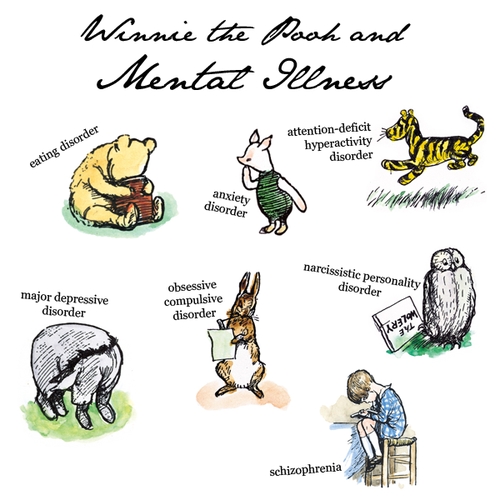Uncovering Winnie The Pooh: Mental Health In The Hundred Acre Wood
Can a children's classic, a world of whimsical characters and honey-loving bears, actually offer insight into the complexities of mental health? The answer, surprisingly, is a resounding yes. The beloved residents of the Hundred Acre Wood, with their endearing quirks and relatable foibles, may, in fact, be walking, talking representations of various mental health conditions.
The enduring appeal of A.A. Milne's Winnie-the-Pooh lies in its seemingly simple narratives and the charming personalities of its inhabitants. However, a closer examination reveals a deeper layer of psychological complexity, offering a unique lens through which to understand mental health disorders. The characters, though fictional, exhibit behaviors and traits that resonate with real-world conditions, sparking both curiosity and critical thought. Research, in fact, has suggested affirmative links between the character traits of these woodland creatures and various mental health disorders, adding a fascinating dimension to our understanding of these timeless stories.
Let's delve into the Hundred Acre Wood and meet its inhabitants, each representing a different facet of human experience and struggle.
| Character | Mental Health Condition | Symptoms/Traits | Supporting Evidence from the Stories |
|---|---|---|---|
| Winnie-the-Pooh | Attention Deficit Hyperactivity Disorder (ADHD) & Obsessive-Compulsive Disorder (OCD) | Inattentiveness, disordered thoughts, forgetfulness, preoccupation with specific activities (honey), repetitive behaviors. | Poohs scattered thoughts, his frequent forgetfulness (e.g., forgetting where he is going or what he was doing), his intense focus on honey, and his repetitive actions (e.g., searching for honey). |
| Piglet | Generalized Anxiety Disorder (GAD) | Chronic worry, nervousness, fearfulness, shyness, avoidance of social situations. | Piglet's constant worry, his fear of the unknown, his tendency to hide, and his general timidity in various situations. |
| Eeyore | Depressive Disorder (Dysthymia or Persistent Depressive Disorder) | Pervasive sadness, pessimism, lack of motivation, low self-esteem, anhedonia (inability to feel pleasure). | Eeyore's consistently gloomy disposition, his low self-esteem, his pessimistic outlook on life, and his general lack of enthusiasm. |
| Tigger | Attention Deficit Hyperactivity Disorder (ADHD) and Bipolar Disorder | Hyperactivity, impulsivity, distractibility, excessive enthusiasm, mood swings. | Tigger's boundless energy, his impulsiveness, his difficulty concentrating, and his tendency to swing between periods of exuberance and periods of sadness or frustration. |
| Rabbit | Obsessive-Compulsive Personality Disorder (OCPD) | Orderliness, perfectionism, control, excessive attention to detail, rigidity, difficulty relaxing. | Rabbit's meticulous planning, his need for order and control, his tendency to overthink things, and his rigid adherence to rules and routines. |
| Owl | Narcissistic Personality Disorder (NPD) | Arrogance, a sense of entitlement, a need for admiration, a lack of empathy. | Owl's tendency to self-aggrandize, his belief in his own intelligence, his condescending behavior towards others, and his lack of genuine concern for the feelings of others. |
Reference:Winnie the Pooh and the Pathology of Everyday Life
Winnie-the-Pooh, at first glance, appears to embody simplicity, a bear of very little brain consumed by the relentless pursuit of honey. However, a closer look reveals a more complex psychological portrait. The research of Shea and her colleagues, and others who have explored the character, points to the presence of several mental disorders within the bear. The one that stands out most is Attention Deficit Hyperactivity Disorder (ADHD). Specifically, his ADHD manifests in the inattentive subtype, revealed through his scattered, disorganized thoughts, random remarks, and frequent forgetfulness. His scattered thoughts and moments of forgetfulness might resonate with those familiar with ADHD.
Pooh's unwavering focus on honey also suggests a potential for obsessive-compulsive tendencies. His single-minded pursuit of the treat, the routines associated with obtaining it, and the potential for repetitive behaviors point to a deeper issue: the concern of obsessive hunger. This is further reflected in his inability to focus on other tasks or situations when his mind is set on his favorite food.
Piglet, a creature of small stature and even smaller courage, embodies the anxieties that many individuals face. He is the quintessential worrier, perpetually concerned about the potential for danger and always seeking the comfort of his friends. His anxiety, constant and pervasive, is a clear reflection of Generalized Anxiety Disorder (GAD). Piglets stories are punctuated with expressions of fear and apprehension, from his hesitation to venture out alone to his tendency to envision worst-case scenarios. His anxiety manifests in his physical reactions, such as trembling, and in his avoidance of social situations and new experiences. He finds security in the company of his friends, particularly Pooh, but his anxiety is a constant companion.
Then there's Eeyore, the perpetually gloomy donkey whose outlook on life is consistently bleak. His demeanor embodies the essence of a Depressive Disorder, specifically Dysthymia or Persistent Depressive Disorder. Eeyore's pervasive sadness, his lack of enthusiasm, and his tendency to view everything in a negative light are telltale signs. His low self-esteem is evident in his self-deprecating remarks and his belief that nothing good will ever happen to him. He rarely experiences joy, highlighting anhedonia, a hallmark symptom of depression. Despite the efforts of his friends, Eeyore remains trapped in a cycle of negativity, a poignant representation of the challenges faced by those battling depression.
Tigger, the irrepressible tiger, bursts into the Hundred Acre Wood with boundless energy and a zest for life. Tigger is the embodiment of hyperactivity and impulsivity, characteristics that align with Attention Deficit Hyperactivity Disorder (ADHD), combined with possible Bipolar Disorder. His energy is contagious, but often overwhelming. He struggles to remain focused, flitting from one activity to another without fully completing any of them. His impulsivity leads him into risky situations and unpredictable behavior. He struggles to manage his emotions. One moment he is leaping with unrestrained joy, and the next, he is experiencing disappointment or frustration. This is most likely ADHD but also Bipolar Disorder is likely.
Rabbit, the meticulous planner and organizer, is the epitome of order and control. Rabbits character traits align perfectly with Obsessive-Compulsive Personality Disorder (OCPD). He is driven by a need for perfection, meticulously planning every detail and striving for absolute control. He is obsessed with order, his home and garden reflecting an unwavering adherence to rules and routines. He is uncomfortable with spontaneity or any deviation from his plans, and he can be overly critical of others who do not share his standards. Rabbits behavior, though seemingly harmless, reveals the internal struggles associated with a rigid and inflexible personality.
Owl, the self-proclaimed wise one, is a character who exemplifies certain aspects of Narcissistic Personality Disorder (NPD). He holds himself in high regard and frequently emphasizes his knowledge and intelligence. His arrogance is evident in his condescending attitude and his tendency to speak down to others. His lack of empathy and his preoccupation with self-importance are classic signs of narcissism. He enjoys the admiration of the other animals and thrives on attention.
Delving into the world of Winnie-the-Pooh and examining its characters through the lens of mental health challenges is not meant to pathologize these beloved figures. Instead, it is an invitation to explore the spectrum of human experience and to gain a deeper appreciation for the diversity of the human psyche. By recognizing the traits and behaviors that mirror real-world conditions, we can cultivate empathy and understanding, both for the characters and for ourselves. The Hundred Acre Wood, in its whimsical charm, provides a valuable framework for discussing mental health and for fostering awareness, compassion, and acceptance.
The enduring popularity of Winnie-the-Pooh is a testament to its timeless appeal. Its ability to resonate with audiences of all ages stems from its ability to capture the essence of human nature. The characters, with their vulnerabilities and eccentricities, allow us to reflect on our own emotions and experiences. In the stories, the focus is on friendship, kindness, and mutual support, which provides a gentle and reassuring context in which to address complex topics.
While the characters are fictional, their struggles and challenges mirror those faced by individuals in the real world. By examining their traits and behaviors, we gain insight into the different mental health conditions that can affect people. Recognizing the links between these characters and mental health can also help reduce stigma and encourage conversations about mental well-being. It promotes a more compassionate and informed perspective on mental health.
Winnie-the-Pooh offers valuable lessons about mental health. The relationships between the characters highlight the importance of empathy, support, and understanding. It shows that even in the face of adversity, friendships and relationships can provide strength and encouragement. It encourages us to be kind and to accept differences, and to be understanding of the challenges faced by others. The characters teach us that it is okay to ask for help, to be vulnerable, and to seek support when needed.
The stories of Winnie-the-Pooh are a valuable resource for promoting mental health awareness. They can be used to facilitate conversations about mental health, to educate children about different conditions, and to encourage empathy and understanding. Educators, parents, and therapists can use the characters as a starting point for discussing difficult topics, such as anxiety, depression, and ADHD, in an approachable and accessible way.
The Hundred Acre Wood and its inhabitants offer a unique and insightful perspective on mental health. By examining the characters through a psychological lens, we gain a deeper appreciation for the complexities of human experience. This whimsical forest, filled with its charming creatures and heartwarming adventures, reminds us of the importance of empathy, compassion, and understanding. The lessons learned from this seemingly simple world can provide strength and inspiration for us all.


